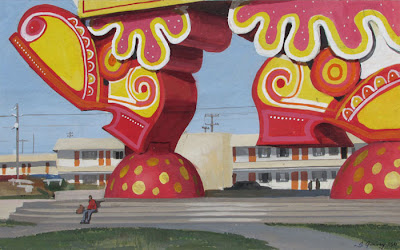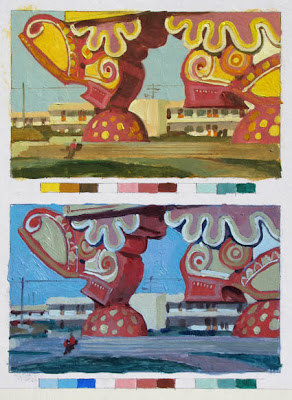
So for this three-post series, we’ll have some fun with the method. Let’s start with the final results, so you can see where we’re heading. Above is a plein air painting of the colorful Circus Circus sign in Las Vegas, painted in gouache.
It has intense local color to start with, and it’s lit by a midday sun from in front. And there’s not much hazy atmospherics. So most of the colors that I used in the painting are pretty close to the local colors I was looking at.

Suppose that later on in the studio you wanted to shift the color scheme in one direction or another, similar to the digital method called “color grading” in film. Of course in Photoshop, you could just move a few sliders around, but how would you do it in paint?
You could shift the color by using a very limited palette of tube colors. But that’s an inexact method because you’re limited to the available pigments. A better method is by premixing within a specific gamut that you select, and I'll explain more tomorrow.
Previously on GJ:
Gamut Masking, Part 1
Gamut Masking, Part 2
Colored Cube Illusion (aka "Color Constancy")
2008 post on color masking
From Mask to Palette (2008)
Color and Light: A Guide for the Realist Painter
Color Grading







6 comments:
This is great. Very much looking forward to your further explanation tomorrow. :)
I'm looking forward to it, too. Actually, I've been wanting for some time to ask you more detail about mixing color strings. Do you intend to tackle the subject in this series of posts? Could you please give us a few examples of color strings and what tubes you use to mix a given string? Thanks you for all these wonderful posts!
Just to be a little more precise, after having established the "family heads", you write
"Next, extend those colors into four different values or tones. Try to keep the hue and the saturation constant as you do so."
How do you keep the hue and saturation constant along the scale? By having different tubes of the same hue but different values?
Arnaud, The actual mixtures for the various steps of a given color are created from a variety of tube colors. It's not a matter of just adding white or black to a single tube color, because doing that usually weakens the chroma or shifts the hues.
Most "subjective primaries" (the colors that occupy each corner of the gamut) are reduced from full chroma in their midrange values, so it's possible to mix tints and shades while keeping the chroma constant.
I realize this may seem confusing, but it should be more clear in Friday's post.
Yes! I wanted to second Arnaud in encouraging you to go over the mixing of color strings. I'm worried I'm missing something. Thank you!
Great tutorial James. I have shared your Youtube video on my blog~
Post a Comment